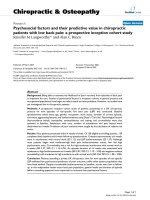Modeling Techniques In Predictive Analytics With Python And R_ A Guide To Data Science
Bạn đang xem bản rút gọn của tài liệu. Xem và tải ngay bản đầy đủ của tài liệu tại đây (22.77 MB, 939 trang )
<span class="text_page_counter">Trang 2</span><div class="page_container" data-page="2">
<b>About This eBook</b>
ePUB is an open, industry-standard format for eBooks. However, support of ePUB and its many
features varies across reading devices and applications. Use your device or app settings to customize the
presentation to your liking. Settings that you can
customize often include font, font size, single or double column, landscape or portrait mode, and figures that you can click or tap to enlarge. For additional
information about the settings and features on your reading device or app, visit the device manufacturer’s Web site.
Many titles include programming code or
configuration examples. To optimize the presentation of these elements, view the eBook in single-column,
landscape mode and adjust the font size to the smallest setting. In addition to presenting code and
configurations in the reflowable text format, we haveincluded images of the code that mimic the presentationfound in the print book; therefore, where the reflowableformat may compromise the presentation of the codelisting, you will see a “Click here to view code image”link. Click the link to view the print-fidelity code image.To return to the previous page viewed, click the Backbutton on your device or app.
</div><span class="text_page_counter">Trang 4</span><div class="page_container" data-page="4">Associate Publisher: Amy Neidlinger Executive Editor: Jeanne Glasser Operations Specialist: Jodi Kemper Cover Designer: Alan Clements Managing Editor: Kristy Hart Project Editor: Andy Beaster
Senior Compositor: Gloria Schurick Manufacturing Buyer: Dan Uhrig © 2015 by Thomas W. Miller
Published by Pearson Education, Inc. Upper Saddle River, New Jersey 07458
Pearson offers excellent discounts on this book when ordered in quantity for bulk purchases or special sales. For more information, please contact U.S. Corporate and Government Sales, 1-800-382-3419,
For sales outside the U.S., please contact International Sales at
Company and product names mentioned herein are the trademarks or registered trademarks of their respective owners.
All rights reserved. No part of this book may be reproduced, in any form or by any means, without permission in writing from the publisher.
Printed in the United States of America
</div><span class="text_page_counter">Trang 5</span><div class="page_container" data-page="5">First Printing October 2014 ISBN-10: 0-13-3892069
ISBN-13: 978-0-13-389206-2 Pearson Education LTD.
Pearson Education Australia PTY, Limited. Pearson Education Singapore, Pte. Ltd. Pearson Education Asia, Ltd.
Pearson Education Canada, Ltd.
Pearson Educacin de Mexico, S.A. de C.V. Pearson Education—Japan
Pearson Education Malaysia, Pte. Ltd.
Library of Congress Control Number: 2014948913
</div><span class="text_page_counter">Trang 6</span><div class="page_container" data-page="6">1 Analytics and Data Science 2 Advertising and Promotion 3 Preference and Choice 4 Market Basket Analysis 5 Economic Data Analysis 6 Operations Management 7 Text Analytics
8 Sentiment Analysis 9 Sports Analytics
10 Spatial Data Analysis 11 Brand and Price
12 The Big Little Data Game A Data Science Methods
A.1 Databases and Data Preparation
</div><span class="text_page_counter">Trang 7</span><div class="page_container" data-page="7">A.2 Classical and Bayesian Statistics A.3 Regression and Classification A.4 Machine Learning
A.5 Web and Social Network Analysis A.6 Recommender Systems
A.7 Product Positioning A.8 Market Segmentation A.9 Site Selection
A.10 Financial Data Science
C.5 Computer Choice Study D Code and Utilities
BibliographyIndex
</div><span class="text_page_counter">Trang 8</span><div class="page_container" data-page="8">—JOHN CLEESE AS REG IN<i> Life of Brian (1979)</i>
“All right . . . all right . . . but apart from better sanitation, the medicine, education, wine, public order, irrigation, roads, a fresh water system, and public health . . . what have the Romans ever done for us?”
I was in a
doctoral-level statistics course at the University of Minnesota in the late 1970s when I learned a lesson about the
programming habits of academics. At the start of the course, the instructor said, “I don’t care what language you use for assignments, as long as you do your own work.”
I had facility with Fortran but was teaching myself Pascal at the time. I was developing a structured programming style—no more GO TO statements. So, taking the instructor at his word, I programmed the first assignment in Pascal. The other fourteen students in the class were programming in Fortran, the lingua franca of statistics at the time.
When I handed in the assignment, the instructor looked at it and asked, “What’s this?”
“Pascal,” I said. “You told us we could program in anylanguage we like as long as we do our own work.”
</div><span class="text_page_counter">Trang 9</span><div class="page_container" data-page="9">He responded, “Pascal. I don’t read Pascal. I only read Fortran.”
Today’s world of data science brings together
information technology professionals fluent in Python with statisticians fluent in R. These communities have much to learn from each other. For the practicing data scientist, there are considerable advantages to being multilingual.
Sometimes referred to as a “glue language,” Python provides a rich open-source environment for scientific programming and research. For computer-intensive applications, it gives us the ability to call on compiled routines from C, C++, and Fortran. Or we can use Cython to convert Python code into optimized C. For modeling techniques or graphics not currently
implemented in Python, we can execute R programs from Python. We can draw on R packages for nonlinear estimation, Bayesian hierarchical modeling, time series analysis, multivariate methods, statistical graphics, and the handling of missing data, just as R users can benefit from Python’s capabilities as a general-purpose
programming language.
Data and algorithms rule the day. Welcome to the new world of business, a fast-paced, data-intensive world, an open-source environment in which competitive
advantage, however fleeting, is obtained through analytic prowess and the sharing of ideas.
Many books about predictive analytics or data sciencetalk about strategy and management. Some focus on
</div><span class="text_page_counter">Trang 10</span><div class="page_container" data-page="10">methods and models. Others look at information
technology and code. This is a rare book does all three, appealing to business managers, modelers, and
programmers alike.
We recognize the importance of analytics in gaining competitive advantage. We help researchers and analysts by providing a ready resource and reference guide for modeling techniques. We show programmers how to build upon a foundation of code that works to solve real business problems. We translate the results of models into words and pictures that management can understand. We explain the meaning of data and
Growth in the volume of data collected and stored, in the variety of data available for analysis, and in the rate at which data arrive and require analysis, makes
analytics more important with each passing day.
Achieving competitive advantage means implementing new systems for information management and
analytics. It means changing the way business is done. Literature in the field of data science is massive,
drawing from many academic disciplines and
application areas. The relevant open-source code is growing quickly. Indeed, it would be a challenge to
provide a comprehensive guide to predictive analytics or data science.
We look at real problems and real data. We offer acollection of vignettes with each chapter focused on aparticular application area and business problem. We
</div><span class="text_page_counter">Trang 11</span><div class="page_container" data-page="11">provide solutions that make sense. By showing
modeling techniques and programming tools in action, we convert abstract concepts into concrete examples. Fully worked examples facilitate understanding. Our objective is to provide an overview of predictive analytics and data science that is accessible to many readers. There is scant mathematics in the book. Statisticians and modelers may look to the references for details and derivations of methods. We describe methods in plain English and use data visualization to show solutions to business problems.
Given the subject of the book, some might wonder if I belong to either the classical or Bayesian camp. At the School of Statistics at the University of Minnesota, I developed a respect for both sides of the
classical/Bayesian divide. I have high regard for the perspective of empirical Bayesians and those working in statistical learning, which combines machine learning and traditional statistics. I am a pragmatist when it comes to modeling and inference. I do what works and express my uncertainty in statements that others can understand.
This book is possible because of the thousands of experts across the world, people who contribute time and ideas to open source. The growth of open source and the ease of growing it further ensures that
developed solutions will be around for many years tocome. Genie out of the lamp, wizard from behind the
</div><span class="text_page_counter">Trang 12</span><div class="page_container" data-page="12">curtain—rocket science is not what it used to be. Secrets are being revealed. This book is part of the process. Most of the data in the book were obtained from public domain data sources. Major League Baseball data for promotions and attendance were contributed by Erica Costello. Computer choice study data were made
possible through work supported by Sharon
Chamberlain. The call center data of “Anonymous Bank” were provided by Avi Mandelbaum and Ilan Guedj.
Movie information was obtained courtesy of The
Internet Movie Database, used with permission. IMDb movie reviews data were organized by Andrew L.
Mass and his colleagues at Stanford University. Some examples were inspired by working with clients at ToutBay of Tampa, Florida, NCR Comten, Hewlett-Packard Company, Site Analytics Co. of New York, Sunseed Research of Madison, Wisconsin, and Union Cab Cooperative of Madison.
We work within open-source communities, sharing code with one another. The truth about what we do is in the programs we write. It is there for everyone to see and for some to debug. To promote student learning, each program includes step-by-step comments and
suggestions for taking the analysis further. All data sets and computer programs are downloadable from the book’s website at
The initial plan for this book was to translate the R
version of the book into Python. While working on what
</div><span class="text_page_counter">Trang 13</span><div class="page_container" data-page="13">was going to be a Python-only edition, however, I gained a more profound respect for both languages. I saw how some problems are more easily solved with Python and others with R. Furthermore, being able to access the wealth of R packages for modeling techniques and graphics while working in Python has distinct
advantages for the practicing data scientist. Accordingly, this edition of the book includes Python and R code examples. It represents a unique dual-language guide to data science.
Many have influenced my intellectual development over the years. There were those good thinkers and good people, teachers and mentors for whom I will be forever grateful. Sadly, no longer with us are Gerald Hahn
Hinkle in philosophy and Allan Lake Rice in languages at Ursinus College, and Herbert Feigl in philosophy at the University of Minnesota. I am also most thankful to David J. Weiss in psychometrics at the University of Minnesota and Kelly Eakin in economics, formerly at the University of Oregon. Good teachers—yes, great teachers—are valued for a lifetime.
Thanks to Michael L. Rothschild, Neal M. Ford, Peter R. Dickson, and Janet Christopher who provided
invaluable support during our years together at the University of Wisconsin–Madison and the A. C. Nielsen Center for Marketing Research.
I live in California, four miles north of Dodger Stadium,teach for Northwestern University in Evanston, Illinois,and direct product development at ToutBay, a data
</div><span class="text_page_counter">Trang 14</span><div class="page_container" data-page="14">science firm in Tampa, Florida. Such are the benefits of a good Internet connection.
I am fortunate to be involved with graduate distance education at Northwestern University’s School of Professional Studies. Thanks to Glen Fogerty, who offered me the opportunity to teach and take a
leadership role in the predictive analytics program at Northwestern University. Thanks to colleagues and staff who administer this exceptional graduate program. And thanks to the many students and fellow faculty from whom I have learned.
ToutBay is an emerging firm in the data science space. With co-founder Greg Blence, I have great hopes for growth in the coming years. Thanks to Greg for joining me in this effort and for keeping me grounded in the practical needs of business. Academics and data science models can take us only so far. Eventually, to make a difference, we must implement our ideas and models, sharing them with one another.
Amy Hendrickson of TEXnology Inc. applied her craft, making words, ta bles, and figures look beautiful in print—another victory for open source. Thanks to
Donald Knuth and the TEX/LATEX community for their contributions to this wonderful system for typesetting and publication.
Thanks to readers and reviewers of the initial R editionof the book, including Suzanne Callender, Philip M.Goldfeder, Melvin Ott, and Thomas P. Ryan. For therevised R edition, Lorena Martin provided much needed
</div><span class="text_page_counter">Trang 15</span><div class="page_container" data-page="15">feedback and suggestions for improving the book. Candice Bradley served dual roles as a reviewer and copyeditor, and Roy L. Sanford provided technical advice about statistical models and programs. Thanks also to my editor, Jeanne Glasser Levine, and publisher, Pearson/FT Press, for making this book possible. Any writing issues, errors, or items of unfinished business, of course, are my responsibility alone.
My good friend Brittney and her daughter Janiya keep me company when time permits. And my son Daniel is there for me in good times and bad, a friend for life. My greatest debt is to them because they believe in me. Thomas W. Miller
Glendale, CaliforniaAugust 2014
</div><span class="text_page_counter">Trang 16</span><div class="page_container" data-page="16">1.1 Data and models for research
1.2 Training-and-Test Regimen for Model Evaluation 1.3 Training-and-Test Using Multi-fold Cross-validation 1.4 Training-and-Test with Bootstrap Resampling
1.5 Importance of Data Visualization: The Anscombe Quartet
2.1 Dodgers Attendance by Day of Week 2.2 Dodgers Attendance by Month
2.3 Dodgers Weather, Fireworks, and Attendance 2.4 Dodgers Attendance by Visiting Team
2.5 Regression Model Performance: Bobbleheads and Attendance
3.1 Spine Chart of Preferences for Mobile Communication Services
4.1 Market Basket Prevalence of Initial Grocery Items 4.2 Market Basket Prevalence of Grocery Items by
4.3 Market Basket Association Rules: Scatter Plot 4.4 Market Basket Association Rules: Matrix Bubble
4.5 Association Rules for a Local Farmer: A NetworkDiagram
</div><span class="text_page_counter">Trang 17</span><div class="page_container" data-page="17">5.1 Multiple Time Series of Economic Data
5.2 Horizon Plot of Indexed Economic Time Series 5.3 Forecast of National Civilian Employment Rate
5.4 Forecast of Manufacturers’ New Orders: Durable Goods (billions of dollars)
5.5 Forecast of University of Michigan Index of Consumer Sentiment (1Q 1966 = 100)
5.6 Forecast of New Homes Sold (millions) 6.1 Call Center Operations for Monday 6.2 Call Center Operations for Tuesday 6.3 Call Center Operations for Wednesday 6.4 Call Center Operations for Thursday 6.5 Call Center Operations for Friday 6.6 Call Center Operations for Sunday
6.7 Call Center Arrival and Service Rates on Wednesdays 6.8 Call Center Needs and Optimal Workforce Schedule 7.1 Movie Taglines from The Internet Movie Database
7.2 Movies by Year of Release
7.3 A Bag of 200 Words from Forty Years of Movie
</div><span class="text_page_counter">Trang 18</span><div class="page_container" data-page="18">7.6 Horizon Plot of Text Measures across Forty Years of Movie Taglines
7.7 From Text Processing to Text Analytics 7.8 Linguistic Foundations of Text Analytics 7.9 Creating a Terms-by-Documents Matrix 8.1 A Few Movie Reviews According to Tom
8.2 A Few More Movie Reviews According to Tom 8.3 Fifty Words of Sentiment
8.4 List-Based Text Measures for Four Movie Reviews 8.5 Scatter Plot of Text Measures of Positive and
9.2 Game-day Simulation (offense only)
9.3 Mets’ Away and Yankees’ Home Data (offense and defense)
9.4 Balanced Game-day Simulation (offense and defense)
9.5 Actual and Theoretical Runs-scored Distributions 9.6 Poisson Model for Mets vs. Yankees at Yankee
Stadium
</div><span class="text_page_counter">Trang 19</span><div class="page_container" data-page="19">9.7 Negative Binomial Model for Mets vs. Yankees at Yankee Stadium
9.8 Probability of Home Team Winning (Negative Binomial Model)
10.1 California Housing Data: Correlation Heat Map for the Training Data
10.2 California Housing Data: Scatter Plot Matrix of Selected Variables
10.3 Tree-Structured Regression for Predicting California Housing Values
10.4 Random Forests Regression for Predicting California Housing Values
11.1 Computer Choice Study: A Mosaic of Top Brands and Most Valued Attributes
11.2 Framework for Describing Consumer Preference and Choice
11.3 Ternary Plot of Consumer Preference and Choice 11.4 Comparing Consumers with Differing Brand
11.5 Potential for Brand Switching: Parallel Coordinates for Individual Consumers
11.6 Potential for Brand Switching: Parallel Coordinates for Consumer Groups
11.7 Market Simulation: A Mosaic of Preference Shares 12.1 Work of Data Science
A.1 Evaluating Predictive Accuracy of a Binary Classifier
</div><span class="text_page_counter">Trang 20</span><div class="page_container" data-page="20">B.1 Hypothetical Multitrait-Multimethod Matrix B.2 Conjoint Degree-of-Interest Rating
B.3 Conjoint Sliding Scale for Profile Pairs B.4 Paired Comparisons
B.5 Multiple-Rank-Orders
B.6 Best-worst Item Provides Partial Paired Comparisons
B.7 Paired Comparison Choice Task
B.8 Choice Set with Three Product Profiles B.9 Menu-based Choice Task
B.10 Elimination Pick List
C.1 Computer Choice Study: One Choice SetD.1 A Python Programmer’s Word CloudD.2 An R Programmer’s Word Cloud
</div><span class="text_page_counter">Trang 21</span><div class="page_container" data-page="21">1.1 Data for the Anscombe Quartet 2.1 Bobbleheads and Dodger Dogs
2.2 Regression of Attendance on Month, Day of Week, and Bobblehead Promotion
3.1 Preference Data for Mobile Communication Services 4.1 Market Basket for One Shopping Trip
4.2 Association Rules for a Local Farmer
6.1 Call Center Shifts and Needs for Wednesdays 6.2 Call Center Problem and Solution
8.1 List-Based Sentiment Measures from Tom’s Reviews 8.2 Accuracy of Text Classification for Movie Reviews
(Thumbs-Up or Thumbs-Down)
8.3 Random Forest Text Measurement Model Applied to Tom’s Movie Reviews
9.1 New York Mets’ Early Season Games in 20079.2 New York Yankees’ Early Season Games in 200710.1 California Housing Data: Original and Computed
</div><span class="text_page_counter">Trang 22</span><div class="page_container" data-page="22">11.1 Contingency Table of Top-ranked Brands and Most Valued Attributes
11.2 Market Simulation: Choice Set Input
11.3 Market Simulation: Preference Shares in a Hypothetical Four-brand Market
C.1 Hypothetical profits from model-guided vehicle selection
C.2 DriveTime Data for Sedans
C.3 DriveTime Sedan Color Map with Frequency Counts C.4 Diamonds Data: Variable Names and Coding Rules C.5 Dells Survey Data: Visitor Characteristics
C.6 Dells Survey Data: Visitor Activities
C.7 Computer Choice Study: Product Attributes
C.8 Computer Choice Study: Data for One Individual
</div><span class="text_page_counter">Trang 23</span><div class="page_container" data-page="23">1.1 Programming the Anscombe Quartet (Python) 1.2 Programming the Anscombe Quartet (R)
2.1 Shaking Our Bobbleheads Yes and No (Python) 2.2 Shaking Our Bobbleheads Yes and No (R)
3.1 Measuring and Modeling Individual Preferences (Python)
3.2 Measuring and Modeling Individual Preferences (R) 4.1 Market Basket Analysis of Grocery Store Data
4.2 Market Basket Analysis of Grocery Store Data (R) 5.1 Working with Economic Data (Python)
5.2 Working with Economic Data (R) 6.1 Call Center Scheduling (Python) 6.2 Call Center Scheduling (R)
7.1 Text Analysis of Movie Taglines (Python) 7.2 Text Analysis of Movie Taglines (R)
8.1 Sentiment Analysis and Classification of Movie Ratings (Python)
8.2 Sentiment Analysis and Classification of Movie Ratings (R)
9.1 Team Winning Probabilities by Simulation (Python)9.2 Team Winning Probabilities by Simulation (R)
</div><span class="text_page_counter">Trang 24</span><div class="page_container" data-page="24">10.1 Regression Models for Spatial Data (Python) 10.2 Regression Models for Spatial Data (R)
11.1 Training and Testing a Hierarchical Bayes Model (R)
11.2 Preference, Choice, and Market Simulation (R) D.1 Evaluating Predictive Accuracy of a Binary Classifier
D.2 Text Measures for Sentiment Analysis (Python) D.3 Summative Scoring of Sentiment (Python)
D.4 Conjoint Analysis Spine Chart (R) D.5 Market Simulation Utilities (R) D.6 Split-plotting Utilities (R)
D.7 Wait-time Ribbon Plot (R)
D.8 Movie Tagline Data Preparation Script for Text Analysis (R)
D.9 Word Scoring Code for Sentiment Analysis (R) D.10 Utilities for Spatial Data Analysis (R)
D.11 Making Word Clouds (R)
</div><span class="text_page_counter">Trang 25</span><div class="page_container" data-page="25">—WALTER BROOKE AS MR. MAGUIRE AND DUSTIN HOFFMAN AS BEN (BENJAMIN BRADDOCK) IN<i> The Graduate (1967)</i>
<b>1. Analytics and Data Science</b>
Mr. Maguire: “I just want to say one word to you, just one word.”
Ben: “Yes, sir.”
Mr. Maguire: “Are you listening?” Ben: “Yes, I am.”
Mr. Maguire: “Plastics.”
While earning a degree in philosophy may not be the best career move (unless a student plans to teach
philosophy, and few of these positions are available), I greatly value my years as a student of philosophy and the liberal arts. For my bachelor’s degree, I wrote an honors paper on Bertrand Russell. In graduate school at the University of Minnesota, I took courses from one of the truly great philosophers, Herbert Feigl. I read about science and the search for truth, otherwise known as epistemology. My favorite philosophy was logical empiricism.
Although my days of “thinking about thinking” (which ishow Feigl defined philosophy) are far behind me, inthose early years of academic training I was able todevelop a keen sense for what is real and what is just
</div><span class="text_page_counter">Trang 26</span><div class="page_container" data-page="26"><i>talk. A model is a representation of things, a rendering</i>
or description of reality. A typical model in data science is an attempt to relate one set of variables to another. Limited, imprecise, but useful, a model helps us to make sense of the world. A model is more than just talk
because it is based on data.
Predictive analytics brings together management,
information technology, and modeling. It is designed for today’s data-intensive world. Predictive analytics is data science, a multidisciplinary skill set essential for success in business, nonprofit organizations, and government. Whether forecasting sales or market share, finding a good retail site or investment opportunity, identifying consumer segments and target markets, or assessing the potential of new products or risks associated with
existing products, modeling methods in predictive analytics provide the key.
Data scientists, those working in the field of predictive analytics, speak the language of business—accounting, finance, marketing, and management. They know about information technology, including data structures,
algorithms, and object-oriented programming. They understand statistical modeling, machine learning, and mathematical programming. Data scientists are
methodological eclectics, drawing from many scientificdisciplines and translating the results of empiricalresearch into words and pictures that management canunderstand.
</div><span class="text_page_counter">Trang 27</span><div class="page_container" data-page="27">Predictive analytics, as with much of statistics, involves searching for meaningful relationships among variables and representing those relationships in models. There are response variables—things we are trying to predict. There are explanatory variables or predictors—things that we observe, manipulate, or control and might relate to the response.
Regression methods help us to predict a response with meaningful magnitude, such as quantity sold, stock price, or return on investment. Classification methods help us to predict a categorical response. Which brand will be purchased? Will the consumer buy the product or not? Will the account holder pay off or default on the loan? Is this bank transaction true or fraudulent?
Prediction problems are defined by their width or number of potential predictors and by their depth or number of observations in the data set. It is the number of potential predictors in business, marketing, and
investment analysis that causes the most difficulty. There can be thousands of potential predictors with weak relationships to the response. With the aid of computers, hundreds or thousands of models can be fit to subsets of the data and tested on other subsets of the data, providing an evaluation of each predictor.
Predictive modeling involves finding good subsets ofpredictors. Models that fit the data well are better thanmodels that fit the data poorly. Simple models are betterthan complex models.
</div><span class="text_page_counter">Trang 28</span><div class="page_container" data-page="28">Consider three general approaches to research and modeling as employed in predictive analytics:
traditional, data-adaptive, and model-dependent. See
figure 1.1. The traditional approach to research, statistical inference, and modeling begins with the
specification of a theory or model. Classical or Bayesian methods of statistical inference are employed.
Traditional methods, such as linear regression and logistic regression, estimate parameters for linear predictors. Model building involves fitting models to data and checking them with diagnostics. We validate traditional models before using them to make
<i><b>Figure 1.1. Data and models for research</b></i>
When we employ a data-adaptive approach, we beginwith data and search through those data to find useful
</div><span class="text_page_counter">Trang 29</span><div class="page_container" data-page="29">predictors. We give little thought to theories or hypotheses prior to running the analysis. This is the world of machine learning, sometimes called statistical learning or data mining. Data-adaptive methods adapt to the available data, representing nonlinear relationships and interactions among variables. The data determine the model. Data-adaptive methods are data-driven. As with traditional models, we validate data-adaptive models before using them to make predictions. Model-dependent research is the third approach. It begins with the specification of a model and uses that model to generate data, predictions, or
recommendations. Simulations and mathematical programming methods, primary tools of operations research, are examples of model-dependent research. When employing a model-dependent or simulation approach, models are improved by comparing generated data with real data. We ask whether simulated
consumers, firms, and markets behave like real
consumers, firms, and markets. The comparison with real data serves as a form of validation.
It is often a combination of models and methods that works best. Consider an application from the field of financial research. The manager of a mutual fund is looking for additional stocks for a fund’s portfolio. A financial engineer employs a data-adaptive model
(perhaps a neural network) to search across thousands of performance indicators and stocks, identifying a
subset of stocks for further analysis. Then, working with
</div><span class="text_page_counter">Trang 30</span><div class="page_container" data-page="30">that subset of stocks, the financial engineer employs a theory-based approach (CAPM, the capital asset pricing model) to identify a smaller set of stocks to recommend to the fund manager. As a final step, using
model-dependent research (mathematical programming), the engineer identifies the minimum-risk capital
investment for each of the stocks in the portfolio.
Data may be organized by observational unit, time, and space. The observational or cross-sectional unit could be an individual consumer or business or any other basis for collecting and grouping data. Data are organized in time by seconds, minutes, hours, days, and so on. Space or location is often defined by longitude and latitude. Consider numbers of customers entering grocery stores (units of analysis) in Glendale, California on Monday (one point in time), ignoring the spatial location of the stores—these are cross-sectional data. Suppose we work with one of those stores, looking at numbers of
customers entering the store each day of the week forsix months—these are time series data. Then we look atnumbers of customers at all of the grocery stores inGlendale across six months—these are longitudinal orpanel data. To complete our study, we locate thesestores by longitude and latitude, so we have spatial orspatio-temporal data. For any of these data structureswe could consider measures in addition to the numberof customers entering stores. We look at store sales,consumer or nearby resident demographics, traffic onGlendale streets, and so doing move to multiple time
</div><span class="text_page_counter">Trang 31</span><div class="page_container" data-page="31">series and multivariate methods. The organization of the data we collect affects the structure of the models we employ.
As we consider business problems in this book, we touch on many types of models, including
cross-sectional, time series, and spatial data models. Whatever the structure of the data and associated models,
prediction is the unifying theme. We use the data we have to predict data we do not yet have, recognizing that prediction is a precarious enterprise. It is the process of extrapolating and forecasting. And model validation is essential to the process.
To make predictions, we may employ classical or
Bayesian methods. Or we may dispense with traditional statistics entirely and rely upon machine learning
algorithms. We do what works. Our approach to predictive analytics is based upon a simple premise:
<b>The value of a model lies in the quality of itspredictions.</b>
We learn from statistics that we should quantify our uncertainty. On the one hand, we have confidence
Within the statistical literature, Seymour Geisser (1929–
<i>2004) introduced an approach best described as Bayesian</i>
<i>predictive inference (</i>Geisser 1993). Bayesian statistics is named after Reverend Thomas Bayes (1706–1761), the creator of Bayes Theorem. In our emphasis upon the success of predictions, we are in agreement with Geisser. Our approach, however, is purely empirical and in no way dependent upon classical or Bayesian thinking.
1
</div><span class="text_page_counter">Trang 32</span><div class="page_container" data-page="32">








